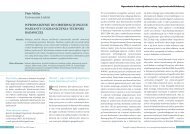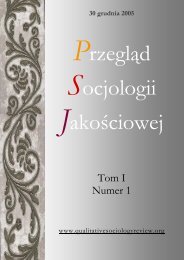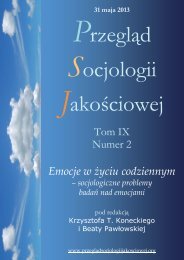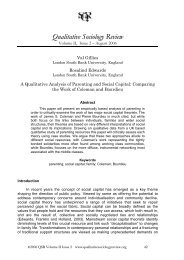Deborah K. van den Hoonaard St. Thomas University, Canada ...
Deborah K. van den Hoonaard St. Thomas University, Canada ...
Deborah K. van den Hoonaard St. Thomas University, Canada ...
Create successful ePaper yourself
Turn your PDF publications into a flip-book with our unique Google optimized e-Paper software.
<strong>Deborah</strong> K. <strong>van</strong> <strong>den</strong> <strong>Hoonaard</strong><br />
Telling the Collective <strong>St</strong>ory: Symbolic Interactionism in Narrative Research<br />
do” or “getting by” is the concept that captures<br />
how they interpret their financial situation either<br />
tive to their needs, their adult children have “their<br />
own lives.” These mothers need to make sure they<br />
be down to watch TV. And he watches the house…<br />
He checks to make sure everything’s all right. (p. 56)<br />
are central to the story highlight that they must<br />
“keep up appearances,” adapt to living as a single<br />
because they are “on a strict budget” or “don’t care<br />
about money” (p. 104). This sensitizing concept<br />
demonstrates older widows’ reluctance to appear to<br />
feel entitled to more than the minimal income many<br />
of them receive. They compare themselves favorably<br />
to women who do not know how to handle money<br />
through narratives of the inability to write a check 2 :<br />
Like I have a friend whose husband died sud<strong>den</strong>ly,<br />
she’d never written a check. She didn’t have a clue…<br />
and it was dreadful for her. She had no idea how<br />
much money there was available, where it was, and<br />
on top of having all the emotional things to deal<br />
with is really, really too much. (p.106)<br />
This situation of not being able to write a check<br />
came up in many of the stories women told about<br />
their friends or acquaintances even though they,<br />
themselves, knew how to write checks. It symbolized<br />
the relationship (or lack thereof) that women<br />
of their generation often had with money while<br />
they were married. The reference to not being able<br />
to write a check allowed the women to compare<br />
themselves positively to women who were not as<br />
well prepared. In fact, learning about finances while<br />
their husbands were still alive is the most common<br />
advice these widows had for other women.<br />
do not overstep an invisible boundary that would<br />
result in invading privacy, crowding, or expecting<br />
too much. Several women demonstrated much creativity<br />
in establishing a new relationship characterized<br />
by reciprocity.<br />
One story of a successful negotiations comes from<br />
one of the very few women who go south for the<br />
winter. She started by explaining:<br />
And my family, well, they’re just wonderful; they’re<br />
friends, as well as family. If I need anything, I only<br />
have to make a phone call. And if I don’t want them<br />
around, they don’t crowd me. (p. 55)<br />
In return, this woman feels comfortable calling on<br />
her children if there’s something she needs help<br />
with, but she usually tries to fix things herself. She<br />
told the story of installing window blinds. She put<br />
up one set of venetian blinds, which took her over<br />
an hour to accomplish. Her son came to visit, and<br />
she went into another room for just a few minutes,<br />
and when she returned, he said:<br />
“Your blind’s up.” He said, “I could have done that the<br />
first time, but I knew you wanted to do it.” So he let<br />
me try it. (p. 56)<br />
This widow’s story of her relationship with her<br />
children exemplifies successful negotiations of<br />
a reciprocal relationship that protects an older<br />
widow’s sense of herself as a competent adult and<br />
recognizes that her children have their own lives.<br />
Not all stories are of equal importance. Kenyon and<br />
Randall (1997:46-47) have developed the concept of<br />
“signature story,” a tale people like to tell about themselves<br />
or situations that they like to narrate. Similarly,<br />
a collective story may include a signature story. In the<br />
study of widows, the signature story communicates<br />
challenge, perseverance, and the development of<br />
a sense of competence and confi<strong>den</strong>ce, all of which<br />
characterize the accomplishments of widows and are<br />
a central part of their collective story:<br />
Well, there’s one thing, for instance, and it’s so simple…when<br />
the hydro goes out on the VCR and the<br />
clock…it’s blinking, twelve o’clock, twelve o’clock.<br />
I never, now this is so simple, I never adjusted that<br />
thing, and I just didn’t even know how to open this<br />
little box there… I left it for about…a week, blinking.<br />
Well, I put up a book so I wouldn’t see it… Yeah, I put<br />
a book up and said [to myself], “I don’t know how<br />
to do it.” So, one day, I went downstairs and I took<br />
my glasses and I said, “I’m going to fix this thing or<br />
woman in a “couples’ world,” find pride in “making<br />
do” with little money, and accept that their children<br />
“have their own lives.” Nonetheless, the collective<br />
story also reflects creativity, resilience, and strength<br />
that belie the stereotype of older widows as helpless.<br />
Sensitizing Concepts in Widowers’<br />
Narratives<br />
For older men who become widowed, the collective<br />
story is different. 3 One of the first questions people<br />
ask when they find out that I’ve studied both widows<br />
and widowers is whether women’s and men’s<br />
experiences are very different from one another.<br />
And how! When asked to describe in a very general<br />
way what it is like to become a widow, many<br />
women talked about how they met their husbands<br />
and what their marriages were like. They could<br />
not tell their story without including information<br />
about what was lost, as well as what had happened.<br />
In response to a similar question, men often talked<br />
about whether or not they wanted to get married<br />
again or observed that women are “after them” as<br />
widowers. 4 It is not surprising, then, that the sensitizing<br />
concepts that construct widowers’ collective<br />
story are different.<br />
The last sensitizing concept in the widows’ stories<br />
is “they have their own lives.” The women used<br />
this phrase to describe their place in their children’s<br />
lives. It recognizes that although most widows<br />
expect their children to be aware of and sensi-<br />
This same woman needed someone to pay her bills<br />
while she was in Florida and to keep an eye on her<br />
house in the winter. Her daughter pays her bills,<br />
and her son checks on her house. She developed<br />
a novel system of reciprocity:<br />
it’s going to be unplugged.” So, I sat down and I got<br />
the instructions out and I just went step by step and<br />
I thought this was a major, oh did a major job. Finally,<br />
I got it. And it was just the idea, I had never done it,<br />
and I had never even looked at the instructions. And<br />
a child, of course, could do it. But, it was a big achievement<br />
there. (<strong>van</strong> <strong>den</strong> <strong>Hoonaard</strong> 2012:123)<br />
The story, for men, revolves around the challenges<br />
widowhood presents to their i<strong>den</strong>tity as masculine,<br />
adult men. I had not expected to approach the widowers’<br />
collective story in terms of masculinity, but<br />
3<br />
Unless otherwise specified, all quotations in this section<br />
come from <strong>van</strong> <strong>den</strong> <strong>Hoonaard</strong> (2010).<br />
2<br />
The interviews took place in the mid 1990s. Today, widows<br />
would more likely talk about ATM’s or internet banking. I am<br />
currently doing a new study to see how the collective story of<br />
older widows has changed in the last 20 years.<br />
Yeah, well, my son is very fond of ice cream, and he<br />
can’t get cable [TV]…and he loves TV. So, I fill the<br />
freezer downstairs with ice cream, and I know he’ll<br />
The collective story of older widows makes visible<br />
their lower status, and the sensitizing concepts that<br />
4<br />
In fact, while I was working on the widower study, I was<br />
interviewed by Anne Kingston for an article she was writing<br />
about widowers for Maclean’s Magazine entitled: “The Sexiest<br />
Man Alive” (2007).<br />
36<br />
©2013 QSR Volume IX Issue 3<br />
Qualitative Sociology Review • www.qualitativesociologyreview.org 37

















